Specialist homelessness services and income support among young people
Citation
AIHW
Australian Institute of Health and Welfare (2024) Specialist homelessness services and income support among young people, AIHW, Australian Government, accessed 27 April 2024.
APA
Australian Institute of Health and Welfare. (2024). Specialist homelessness services and income support among young people. Retrieved from https://pp.aihw.gov.au/reports/homelessness-services/shs-income-support-among-young-people
MLA
Specialist homelessness services and income support among young people. Australian Institute of Health and Welfare, 15 March 2024, https://pp.aihw.gov.au/reports/homelessness-services/shs-income-support-among-young-people
Vancouver
Australian Institute of Health and Welfare. Specialist homelessness services and income support among young people [Internet]. Canberra: Australian Institute of Health and Welfare, 2024 [cited 2024 Apr. 27]. Available from: https://pp.aihw.gov.au/reports/homelessness-services/shs-income-support-among-young-people
Harvard
Australian Institute of Health and Welfare (AIHW) 2024, Specialist homelessness services and income support among young people, viewed 27 April 2024, https://pp.aihw.gov.au/reports/homelessness-services/shs-income-support-among-young-people
Get citations as an Endnote file: Endnote
On this page:
Introduction
People experiencing or at risk of homelessness are among Australia’s most socially and economically disadvantaged. Youth homelessness can be caused by a range of factors, including difficult home lives and challenging family relationships (Gaetz et al. 2016; Kalemba et al. 2022). Family relationships and home lives featuring neglect, conflict, and abuse (including physical, sexual, substance and/or emotional) have severe impacts on young person’s living conditions emotionally and/or physically. While some young people may endure these difficult home lives, many also leave, even without another home to move to (Kalemba et al. 2022).
Specialist homelessness services (SHS) provide support to people experiencing homelessness or facing housing insecurity and are delivered across Australia by non-government organisations. In 2022–23, around 52,300 SHS clients (19% of all SHS clients) were young people aged 15–24, and a further 50,000 (18%) were aged 25–34 (AIHW 2023a). In 2022–23, the most common main reasons for young people presenting alone were housing crisis (19%), followed by family and domestic violence (15%).
Other supports and services are provided to young people at risk of, or experiencing, homelessness, including income support (Services Australia 2023). In June 2023, 495,900 people aged 16–24 received an income support payment, which was a decrease from 530,000 in June 2022 (DSS 2023). Income support payments are regular payments to help with the everyday costs of living, with the type of payment usually reflecting life circumstances at the time of receipt. For example, Student payments support people who are studying or undertaking an apprenticeship, and Parenting Payments support principal carers, recognising the impact that caring for young children can have on a parent’s capacity to undertake full-time employment.
One of the services provided by SHS agencies is to provide 'Assistance to obtain/maintain a government allowance' to support people to access government payments such as income support (AIHW 2018). There have been very few examples of linking data from the homelessness and income support systems. Most recently, the Pathways to Homelessness report explored homelessness and service use in NSW and found that around two-thirds (65%) of people accessing homelessness services between 2011–12 and 2016–17 also received income support in the same quarter (Taylor Fry 2021).
This article specifically explores the relationship between SHS use and income support for young people aged 16–30 years. The analysis used a novel linked data asset, developed by the Australian Institute of Health and Welfare (AIHW) in collaboration with key government stakeholders, linking the Specialist Homelessness Services collection (SHSC) and receipt of social security payments from the Data over Multiple Individual Occurrences (DOMINO) data asset. See the Methodology section below for details about the cohort approach and linkage rates.
The income support payments included in the analysis were:
- unemployment payments (Youth Allowance Other, Newstart Allowance, JobSeeker)
- student payments (ABSTUDY, Austudy, Youth Allowance Student)
- Disability Support Pension
- Parenting Payment Partnered
- Parenting Payment Single
- other payments (includes Carer Payment, Special Benefit, Sickness Allowance, Double Orphan Pension).
Key findings
- Over two-thirds (69%) of young people receiving SHS support also received income support, almost 4 times as high as those who did not receive SHS support (18%).
- Income support among young people receiving SHS support increased from 33% among 16-year-olds to 72% at age 20 and remained similar throughout young adulthood.
- The type of income support received by young SHS clients changed with age – 28–41% of SHS clients aged 19–30 received unemployment payments (the most common payment type), Parenting Payment Single (12–29%) was the next most common, and student payments were most common among teenagers.
- Housing issues was the most common main reason young people sought SHS support (31–43%) at all ages, irrespective of receipt of income support.
- 1 in 4 (26–27%) people aged between 16–18 who received Parenting Payment Single also accessed SHS support in the same year; by the age of 25 around 1 in 16 people (6.1%) receiving income support accessed SHS regardless of income support payment type.
The data used in this study is based on all people aged 16 to 30 between 2011–12 and 2020–21, regardless whether they received SHS or income support (Figure Income.1). The analysis is then divided into 2 parts (Figures Income.2 and Income.3).
Figure Income.1: Study population
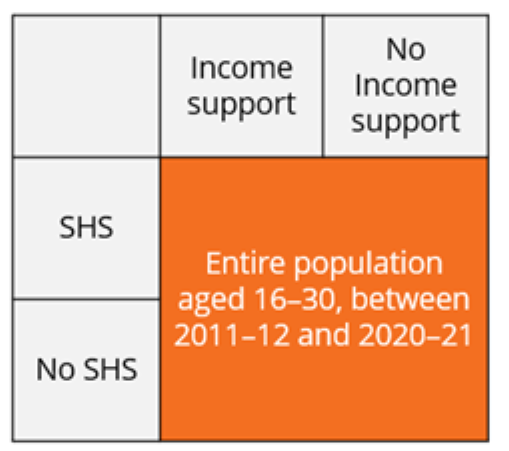
Figure Income.2: Analysis 1 – Specialist homelessness service use among young people and income support status
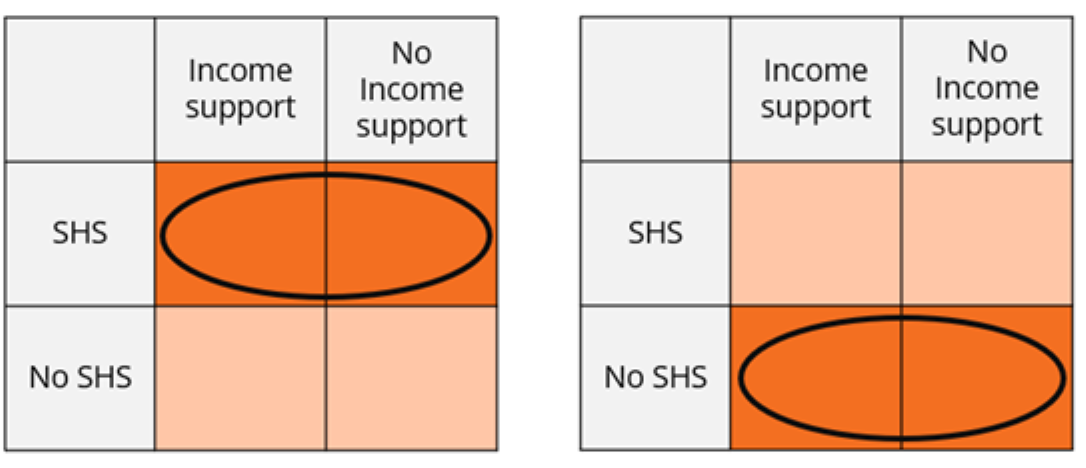
Figure Income.3: Analysis 2 – Income support types among young people and SHS support status
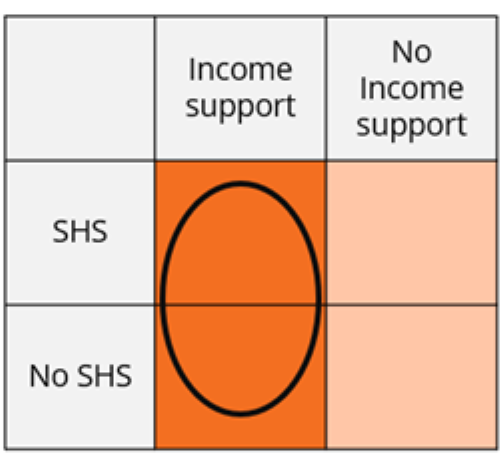
The SHS use among young people and income support status section presents analysis 1 focussing on age, income support types, and main reason for SHS support. The Income support types among young people and SHS support status section presents analysis 2 focussing on income support types.
Note, that the results indicate whether a person received SHS and income support in the same year, not necessarily at the same time (specific day or month of the year).
Specialist homelessness service use among young people and income support status
The focus of this section is whether young people receive SHS support and/or income support payments. For more detail see Interpretative notes.
Over two-thirds of young people receiving SHS support also received income support – at age 16 around one-third received income support increasing to around three-quarters throughout young adulthood.
Among young people at ages 16–30 born between 1990–91 and 2000–01, those who were SHS clients (69%) were 3.8 times as likely to receive income support as those who did not receive SHS support (18%) (Figure Income.4).
Figure Income.4: Young people aged 16–30, by receipt of SHS support and income support (per cent), 2011–21
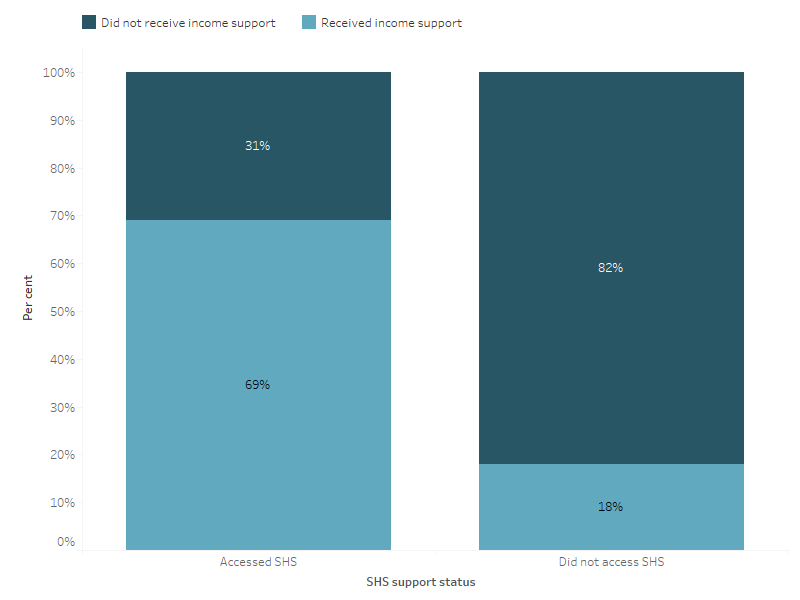
Source: DOMINO-SHSC linked analysis dataset.
Young people who were SHS clients were more likely to receive income support after the age of 18 – increasing from 33% at age 16 to 67% at age 18 and then remaining relatively stable among SHS clients aged 19–30 (71–75%) (Figure Income.5). Among young people who did not access SHS, the proportion who received income support was also lowest at age 16 (4.0%), increasing to almost one-quarter by the age of 19 (24%), before falling to 13% by the age of 30.
Figure Income.5: Young people aged 16–30, by SHS support status, age and receipt of income support (per cent), 2011–21
A stacked vertical bar graph showing the proportion of people by their SHS and income support status, for each age. At age 16, 33% of people accessing SHS also received income support, increasing to between 71% and 75% from age 19 onwards.
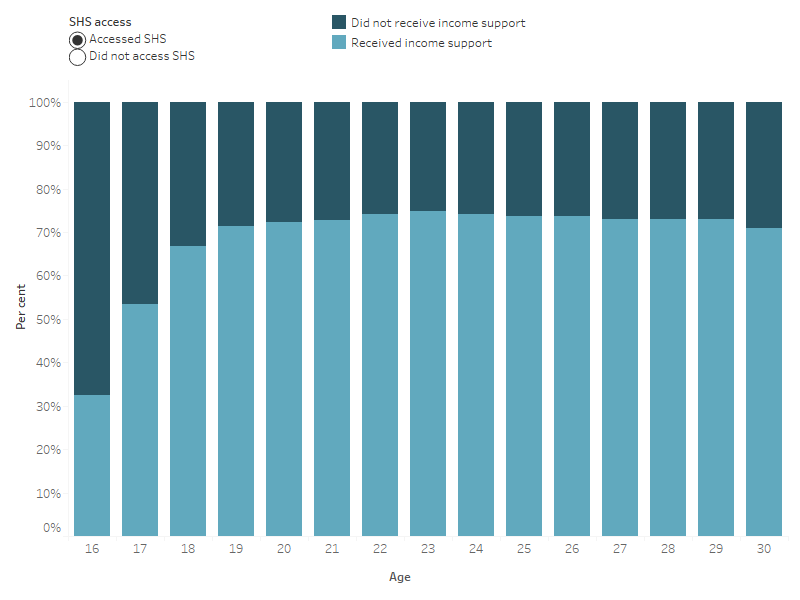
Note: Age is calculated according to the age a person turned in the financial year.
Source: DOMINO-SHSC linked analysis dataset. Supplementary Table 1.
Income support payments among young people
Income support payments among people who received SHS support
The type of income support received changed with age among young people who accessed SHS – student payments more common in younger years and unemployment and single parenting payments more common in people aged in their late 20s.
The type of income support payments received by young people accessing SHS support differed by age (Figure Income.6). The main findings include:
- Unemployment payments were the most common income support payment received from age 17, peaking at 19 years (41%), then falling to below 30% from 25 years.
- Parenting Payment Single was the second most common income support payment, doubling from 7.8% at age 18 to 16% at age 20. Between the ages 24–30, the proportion of SHS clients who received Parenting Payment Single and unemployment payments was similar (28–30%).
- Disability Support Pension was one of the least common payments received in younger ages, however, increased with age, from 4.2% at age 18 to 9.7% at age 30.
The proportion of SHS clients who received Student payments was highest at age 17 (19%). This may fall after age 17 as young people transition out of school and into employment or other types of income support. The proportion then fell to less than 2% between the ages of 24 and 30. This pattern may be partly because young people aged 16–24 are eligible for Youth Allowance (student), which makes up a large proportion of Student payments (DSS 2023).
Figure Income.6: Young people at ages 16–30, by SHS support status, age and income support payment type (per cent), 2011–21
A stacked vertical bar graph showing the proportion of income support type received, by age and SHS status. The income support type received changed with age among young people who accessed SHS.
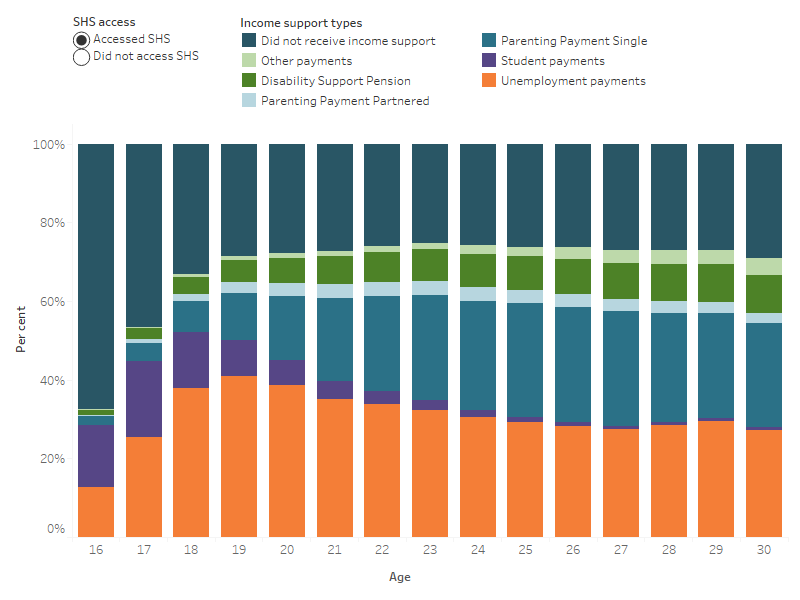
Source: DOMINO-SHSC linked analysis dataset. Supplementary Table 1.
Income support payments among people who did not access SHS support
Among young people who did not access SHS, the proportion who received income support ranged from 4.0% of those aged 16, to 24% of those aged 19 (Figure Income.6). Other insights include:
- Student payments were the most common income support payment received at ages 18 to 22 (8.4–12%). At the age of 23, Student payments had dropped to 6.5% and to below 2.0% at the age of 27 and older.
- Unemployment payments were the second most common income support payment received at ages 17 to 22 year olds (2.8–8.4%) and the most common payment type for 23 to 30 year olds (5.5–8.1%).
- Parenting Payment Single were received by less than 1% of 16 year olds, and by less than 3% of 24–30 year olds (2.5–2.9%).
- Disability Support Pension was received by fewer than 2% of 16 to 30 year olds (0.9–1.9%).
Compared with young people who accessed SHS, those who did not access SHS were:
- more likely to be receiving Student payments after the age of 18
- less likely to be receiving all other payment types.
Main reasons for seeking SHS support among young people and income support status
Housing issues was the most common main reason young people sought SHS support among those who received and those who did not receive income support.
When SHS clients receive support, they describe their main reason for seeking assistance. Housing issues were the most common main reason reported by SHS clients who also received income support payments (ranging from 40% of 16 year olds to 35% of 30 year olds) (Figure Income.7). For those not receiving income support, housing issues was also the most common reason among clients aged 18 to 22 (35–37%), while relationship issues was the most common main reason among clients aged 16–17 and 23–30. The least common main reason for seeking SHS assistance regardless of whether someone received income support was transitioning from care or other custodial arrangements (for example, foster care, prison, hospital, or disability care arrangements). However, this main reason was more common among people who did not receive income support than for those who did – among 30 year olds who did not receive income support (8.8%) the proportion was 2.8 times as high than as for those who did receive income support (3.1%).
Figure Income.7: Young SHS clients at ages 16–30, by main reason for seeking SHS assistance and income support status (per cent), 2011–21
A vertical bar graph showing for those people who received SHS support, the proportion of people by income support status and by their main reason for seeking SHS services. Across most ages, housing issues was the most common main reason for support for both people receiving and not receiving income support.
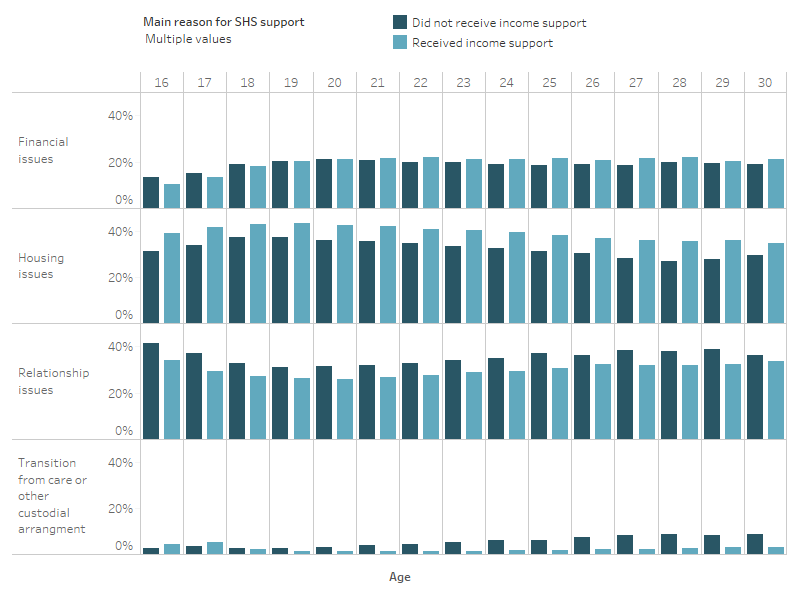
Note: People may have multiple support periods at each age, and therefore can be recorded for more than one main reason at each age. If they start multiple support periods at the same age, with the same main reason, they will only be recorded once against that main reason at that age.
Source: DOMINO-SHSC linked analysis dataset. Supplementary Table 2.
Of those young people whose main reason for receiving SHS support was because they were transitioning from care or other custodial arrangements, almost half (47%) did not receive income support (Supplementary table 3). This increased with age, from around one-third (36%) of 17 year olds who did not receive income support, to more than half (57%) of 27 year olds. The proportion of young people accessing SHS because they were transitioning from care or other custodial arrangements and not receiving income support (47%) was much higher than SHS clients with other main reasons – relationship issues (34% not receiving income support), health issues (29%), financial issues (28%) and housing issues (26%).
Income support types among young people and SHS support status
The focus of this section is young people who received income support. For more detail see Interpretative notes.
By the age of 25 around 1 in 16 people receiving income support accessed SHS regardless of income support payment type.
More than half (54%) of people born between 1990–91 and 2000–01 received income support when they were young (16–30 years); 5.7% received both income support and SHS (AIHW 2023b).
Among those who received income support, the proportion who received support from SHS agencies varied by age group and income support type (Figure Income.8). In general, younger age groups who received income support were more likely to also access SHS than older age groups and the proportion differed by income support type.
- Around one-quarter of 16 to 18 year olds who received Parenting Payment Single also accessed SHS (26–27%).
- Less than one-quarter of 16 to 18 year olds who received Parenting Payment Partnered also accessed SHS (19–24%).
- Fewer than 1 in 20 people aged 16 to 18 who received the Disability Support Pension also accessed SHS (2.0–5.1%); by age 19–30, the proportion increased (5.5–6.1%).
Figure Income.8: Young people aged 16–30, by income support payment type, age, and SHS support status (per cent), 2011–21
A stacked vertical bar graph showing for those people who received income support, the proportion of people by SHS support status, for each income support payment type and age.
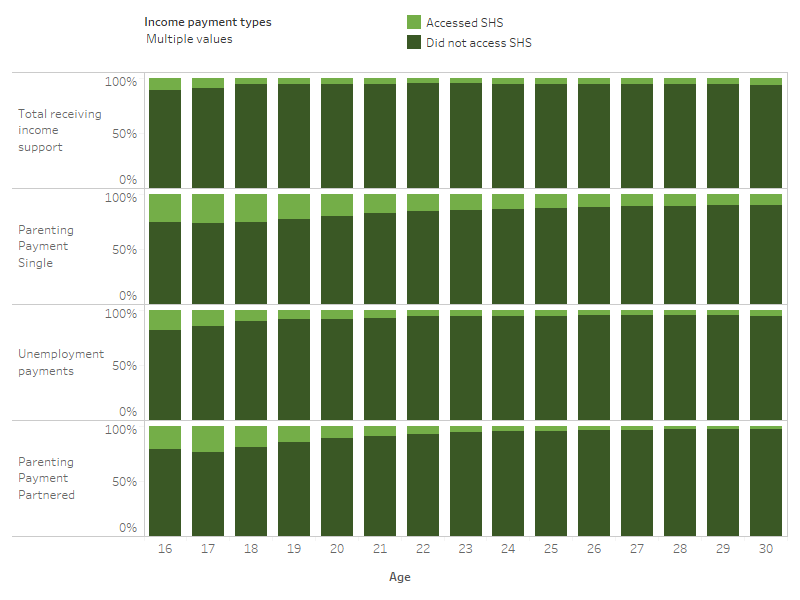
Source: DOMINO-SHSC linked analysis dataset. Supplementary Table 4.
Conclusion
There are differences in income support receipt among young people who accessed SHS and those who did not. Young people who access SHS support are more likely to receive income support, and the type of income support received differs by age. Furthermore, the main reason young people access SHS support changed depending on if they did or didn’t receive income support and by age, however, housing crisis was common among all accessing SHS support.
The disruptive effect of experiencing homelessness during one’s youth can have many far-reaching effects (Heerde and Patton 2020). Disruptions to education and transition to employment can have an impact on future job opportunities and potential earnings, while disruptions to social life can harm social networks. Harsh living conditions can leave young people traumatised and at greater risk of experiencing persistent homelessness (Scutella et al. 2012). These far-reaching impacts are often unique to young people’s experience of homelessness, as many have not yet developed the skills required for independent living.
A better understanding of how young people at risk of, and experiencing, homelessness interact with income support is crucial to understanding the youth homelessness landscape, and this information can improve the evidence base used in policy development and decision making.
Methodology and interpretative notes
A novel data set was created linking the SHSC and Centrelink data from DOMINO (Data over Multiple Individual Occurrences). For further detail on the linkage methodology including linkage rates and further technical interpretative material, see Specialist homelessness service usage and receipt of income support for people transitioning from out-of-home care (AIHW 2023b).
Data used throughout this article is the Comparator populations cohorts.
The study population was defined as:
- people born between 1 July 1990 and 30 June 2001
- people aged 16–30
- SHS and income support data between 2011–12 and 2020–21.
The data are longitudinal which means an individual may appear in many age groups, as a person may receive SHS support and/or income support over a period that spans multiple years.
Some of the analyses examine service usage across the entire observation period, from 2011–21. For these analyses, each person in the population will be counted once. Other analyses, including where results are presented by age, examine service usage within a particular financial year. In these cases, people are counted at each age they received a service within the observation period and may be counted at more than one age. See the Appendix of the Specialist homelessness service usage and receipt of income support for people transitioning from out-of-home care report (AIHW 2023b) and the footnotes in the source table for each figure, for more detail on the methodology used.
The methods used to create the dataset mean that some age groups have a smaller sample size than others. For example, the 21 year old age group is made up of 10 birth cohorts between 1990–91 to 1999–00, whereas the 30 year old age group is made up of one birth cohort (1990–91) (Figure Income.9). Therefore, many of the results are presented as proportions rather than number of people to support comparisons at different age groups.
Figure Income.9: Study age group and birth cohort structure
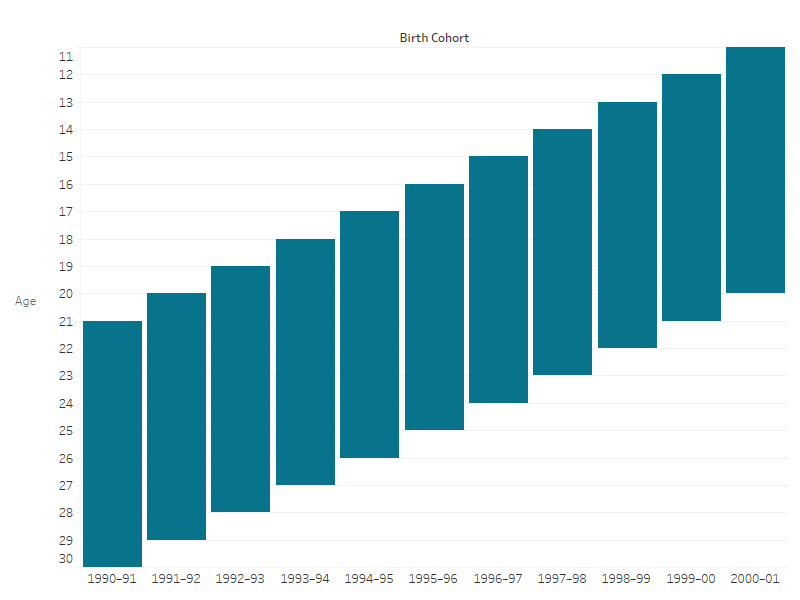
The majority of data relates to the period prior to the COVID-19 pandemic, which began in 2020. Several states and territories implemented emergency policies during the COVID-19 pandemic such as providing short-term or emergency accommodation, and increased support for family and domestic violence services which may have been funded outside the SHS program funding stream and therefore not included in this project (AIHW 2022). Changes were also made to government payments to protect those whose income was adversely affected by the pandemic. This included a coronavirus supplement for recipients of unemployment, parenting, and student payments. This may influence data between 2019–21. Between March and June 2020, a large increase in government payments to people aged 16–24 was observed (405,800 to 656,300 people), largely driven by an increase in unemployment payments (DSS 2023). For more insight on income support payments and trends, see the AIHW’s topic summary: Income and income support (AIHW 2023c).
Australian Institute of Health and Welfare (AIHW) (2023a) Specialist homelessness services annual report 2022–23, AIHW, Australian Government, accessed 12 December 2023.
AIHW (2023b) Specialist homelessness service usage and receipt of income support for people transitioning from out-of-home care, AIHW, Australian Government, accessed 20 December 2023. doi:10.25816/kn3s-9d87
AIHW (2023c) Income and income support, AIHW, Australian Government, accessed 20 December 2023.
AIHW (2022) Income support receipt for young people transitioning from out-of-home care 2022, AIHW, Australian Government, accessed 31 May 2023. doi:10.25816/yp92-ex68
AIHW (2018) Client—service activity type, homelessness code N[N], METEOR Metadata Online Registry, AIHW, accessed 16 November 2023.
Department of Social Services (DSS) (2023) DSS Benefit and Payment Recipient Demographics - quarterly data [data set], data.gov.au, accessed 1 September 2023.
Gaetz S, O’Grady B and Schwan S (2016) Without a Home: The National Youth Homelessness Survey, Homeless Hub, Toronto: Canada.
Heerde JA and Patton GC (2020) The vulnerability of young homeless people, Lancet, 5(6):302–3, doi:10.1016/S2468-2667(20)30121-3.
Kalemba J, Kos A, Greenland N, Plummer J, Brennan N, Freeburn T, Nguyen T and Christie R (2022) Without a home: First-time youth homelessness in the COVID-19 period, Mission Australia.
Scutella R, Johnson G, Moschion J, Tseng Y and Wooden M (2012) Wave 1 Findings, Journeys Home Research Report No. 1, report to the Australian Government Department of Families, Housing, Community Services and Indigenous Affairs (FaHCSIA), Melbourne Institute of Applied Economic and Social Research.
Services Australia (2023) A guide to Australian Government payments, Services Australia website, accessed 5 October 2023.
Taylor Fry (2021) Pathways to Homelessness, report to the New South Wales Communities and Justice, accessed 22 March 2023.


